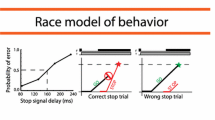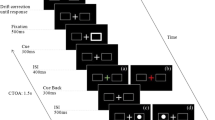Abstract
Identifying a stimulus as the target for a goal-directed movement involves inhibiting competing responses. Separable inhibitory interconnections bias local competition to ensure only one stimulus is selected and to alter movement initiation. Behavioural evidence of these inhibitory processes comes from the effects of distracters on oculomotor landing positions and saccade latencies. Here, we investigate the relationship between these two sources of inhibition. Targets were presented with or without close and remote distracters. In separate experiments the possible position and identity of the target and distracters were manipulated. In all cases saccade landing position was found to be less affected by the presence of the close distracter when remote distracters were also present. The involuntary increase in the latency of saccade initiation caused by the presence of the remote distracters alters the state of competitive processes involved in selecting the saccade target thus changing its landing position.



Similar content being viewed by others
Notes
Main effect of target distance (F 1,12 = 7.1, p < 0.05); interaction between target distance and experiment (F 1,12 = 9.2, p < 0.05) and an interaction between global distracter and target distance (F 1,12 = 8.32, p < 0.05). These stem from latencies elicited to near targets. Latencies are longer for near targets in experiment 2b and over both experiments the presence of the ipsilateral distractor reduced saccade latency to the near target but not those to the far target. It is unclear what could be underlying this effect, but it has no bearing on the current investigation.
References
Allport A (1993) Attention and Control: have we been asking the wrong questions—a critical review of the last twenty-five years. In: Meyer DE, Kornblum S (eds) Attention and performance XIV: a silver jubilee. MIT, Cambridge, pp 183–218
Bruce CJ, Goldberg ME (1985) Primate frontal eye fields. I. Single neurons discharging before saccades. J Neurophysiol 53(3):603–635
Chou IH, Sommer MA, Schiller PH (1999) Express averaging saccades in monkeys. Vision Res 39:4200–4216
Coëffé C, O’Regan JK (1987) Reducing the influence of non-target stimuli on saccade accuracy: predictability and latency effects. Vision Res 27:227–240
Desimone R, Duncan J (1995) Neural mechanisms of selective visual attention. Ann Rev Neurosci 18:193–222
Deubel H, Wolf W, Hauske M (1984) The evaluation of the oculomotor error signal. In: Gale AG, Johnson FW (eds) Theoretical and applied aspects of oculomotor research. Elsevier, Amsterdam, pp 55–62
Findlay JM (1981) Local and global influences on saccadic eye movements. In: Fisher DF, Monty RA, Senders JW (eds) Eye movements, cognition and visual perception. Lawrence Erlbaum, Hillsdale, pp 171–179
Findlay JM (1982) Global processing for saccadic eye movements. Vision Res 22:1033–1045
Findlay JM, Brown V (2006) Eye scanning of multi-element displays: Ii. Saccade planning. Vision Res 46:216–227
Findlay JM, Walker R (1999) A model of saccadic eye movement generation based on parallel processing and competitive inhibition. Behav Brain Sci 22:661–721
Gandhi NJ, Keller EL (1995) Interrupting saccades by electrical stimulation of the superior colliculus determines an extended fixation zone. Soc Neurosci Abstr 21:1193
Glimcher PW, Sparks DL (1993) Representation of averaging saccades in the superior colliculus of the monkey. Exp Brain Res 95:429–435
Godijn R, Theeuwes J (2002) Parallel programming of saccades: evidence for a competitive inhibition model. J Exp Psychol Hum Percept Perform 28:1039–1054
Goldberg ME, Bisley JW, Powell KD, Gottlieb J (2006) Saccades, salience and attention: the role of the lateral intraparietal area in visual behavior. ProgBrain Res 155:157–175
Hanes DP, Schall JD (1996) Neural control of voluntary movement initiation. Science 274:427–430
Hikosaka O (1989) Role of basal ganglia in initiation of voluntary movements. In: Arbib MA, Amari S (eds) Dynamic interactions in neural networks: models and data. Springer-Verlag, New York, pp 153–167
Hikosaka O, Takikawa Y, Kawagoe R (2000) Role of the basal ganglia in the control of purposive saccadic eye movements. Physiol Rev 80:953–978
Honda H (2005) The remote distracter effect of saccade latencies in fixation-offset and overlap conditions. Vision Research 45:2773–2779
Kopecz K (1995) Saccadic reaction time in gap/overlap paradigm: a model based on integration of intentional and visual information on neural, dynamic fields. Vision Res 35:2911–2925
Lee P, Hall WC (2006) An in vitro study of horizontal connections in the intermediate layer of the superior colliculus. J Neurosci 26:4763–4768
Lee C, Rohrer WH, Sparks DL (1988) Population coding of saccadic eye movements by neurons in the superior colliculus. Nature 332:357–360
Ludwig CJH, Gilchrist ID (2003) Target similarity affects saccade curvature away from irrelevant onsets. Exp Brain Res 152:60–69
Ludwig CJ, Mildinhall JW, Gilchrist ID (2007) A population coding account for systematic variation in saccadic dead time. J Neurophysiol 97:795–805
McIlwain JT (1986) Point images in the visual system: New interest in an old idea. Trends Neurosci 9:354–358
McIlwain JT (1991) Distributed spatial coding in the superior colliculus: a review. Vis Neurosci 6:3–13
McPeek RM (2006) Incomplete suppression of distracter-related activity in the frontal eye field results in curved saccades. J Neurophysiol 96:2699–2711
McPeek RM, Han JH, Keller EL (2003) Competition between saccade goals in the superior colliculus produces saccade curvature. J Neurophysiol 89:2577–2590
McSorley E, Findlay JM (2003) Saccade target selection in visual search: accuracy improves when more distracters are present. J Vis 3:877–892
McSorley E, Haggard P, Walker R (2006) Time-course of oculomotor inhibition revealed by saccade trajectory modulation. J Neurophysiol 96:1420–1424
Munoz DP, Istvan PJ (1998) Lateral inhibitory interactions in the intermediate layers of the monkey superior colliculus. J Neurophysiol 79:1193–1209
Munoz DP, Wurtz RH (1993) Fixation cells in monkey superior colliculus. I. Characteristics of cell discharge. J Neurophysiol 70:559–575
Munoz DP, Wurtz RH (1995a) Saccade-related activity in monkey superior colliculus 1: characteristics of burst and buildup cells. J Neurophysiol 73:2313–2333
Munoz DP, Wurtz RH (1995b) Saccade-related activity in monkey superior colliculus 2. Spread of activity during saccades. J Neurophysiol 73:2334–2348
Olivier E, Dorris MC, Munoz DP (1999) Lateral interactions in the superior colliculus, not an extended fixation zone, can account for the remote distracter effect. Behav Brain Sci 22:694–695
Ottes FP, Van Gisbergen JAM, Eggermont JJ (1984) Metrics of saccade responses to visual double stimuli: two different modes. Vision Res 24(10):1169–1179
Ottes FP, Van Gisbergen JAM, Eggermont JJ (1985) Latency dependence of colour-based target vs nontarget discrimination by the saccadic system. Vision Res 25:849–862
Port NL, Wurtz RH (2003) Sequential activity of simultaneously recorded neurons in the superior colliculus during curved saccades. J Neurophysiol 90:1887–1903
Ratcliff R, Hasegawa YT, Hasegawa YP, Smith PL, Segraves MA (2007) Dual diffusion model for single-cell recording data from the superior colliculus in a brightness-discrimination task. J Neurophysiol 97:1756–1774
Schall JD, Thompson KG (1999) Neural selection and control of visually guided eye movements. Ann Rev Neurosci 22:241–259
Sommer MA, Wurtz RH (2004a) What the brain stem tells the frontal cortex. I. Oculomotor signals sent from superior colliculus to frontal eye field via mediodorsal thalamus. J Neurophysiol 91:1381–1402
Sommer MA, Wurtz RH (2004b) What the brain stem tells the frontal cortex. II. Role of the SC–MD–FEF pathway in corollary discharge. J Neurophysiol 91:1403–1423
Trappenberg TP, Dorris MC, Munoz DP, Klein RM (2001) A model of saccade initiation based on the competitive integration of exogenous and endogenous signals in the superior colliculus. J Cognitive Neurosci 13:256–271
van Opstal AJ, van Gisbergen JAM (1989) A nonlinear model for collicular spatial interactions underlying the metrical properties of electrically elicited saccades. Bio Cybern 60:171–183
Walker R, Kentridge RW, Findlay JM (1995) Independent contributions of the orienting of attention, fixation offset and bilateral stimulation on human saccadic latencies. Exp Brain Res 103:294–310
Walker R, Deubel H, Schneider WX, Findlay JM (1997) Effect of remote distracters on saccade programming: Evidence for an extended fixation zone. J Neurophysiol 78:1108–1119
Wurtz RH, Sommer MA (2004) Identifying corollary discharges for movement in the primate brain. Prog Brain Res 144:47–60
Acknowledgments
The work was funded by a grant from the Engineering and Physical Sciences Research Council (awarded to E.M.). Thanks to Casimir Ludwig and an anonymous reviewer for helpful comments.
Author information
Authors and Affiliations
Corresponding author
Rights and permissions
About this article
Cite this article
Cruickshank, A.G., McSorley, E. Involuntary inhibition of movement initiation alters oculomotor competition resolution. Exp Brain Res 193, 467–476 (2009). https://doi.org/10.1007/s00221-008-1645-9
Received:
Accepted:
Published:
Issue Date:
DOI: https://doi.org/10.1007/s00221-008-1645-9




